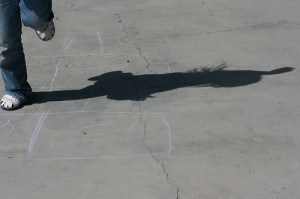I’ve always harbored a secret wish to travel back in time and visit a one room school house. When I was younger I used to fantasize about what they were like as I’d read about them in books like Little House on the Prairie or Anne of Green Gables.

Now as a homeschooling mother of many children I have my own “one room schoolhouse.” There are a few things I would like to ask those school teachers of long ago! How did the teacher handle all those children in varying grades? Did the children work silently? Or was there a general whispered hum? How did the teacher organize it so that the children were occupied while she worked with another group? And, how did the teacher keep track of what to teach and when?
While I don’t have all those answers I have learned some ‘tricks of the trade’ to help when homeschooling so many on different academic levels as well as keeping the toddlers and baby occupied too.
Read Out Loud
Children of all ages, from preschool to teenagers, enjoy listening to good stories. Adults like it too. Reading can be done to help quiet children down, or when the baby needs to be nursed, or at the beginning of the school day to corral everyone together. Who wouldn’t want to come to school and listen to the next exciting chapter?
Here are a few books suggestions to get you started:
- The Little House on the Prairie Series by Laura Ingalls Wilder
- Caddie Woodlawn by Carol Ryrie Brink
- Trumpet of the Swan by E.B. White
- Just David by Eleanor Porter
While reading a chapter book is a good way to share great literature with your children don’t forget the power of looking at a toddler’s favorite picture book with the whole family, or reading a short story, or even some poems. Take turns reading out loud to help children develop their reading and annunciation skills. Ten minutes a day is all it takes to get the whole family hooked on reading together!
Memorization
Memorizing poems, quotations, and historical speeches was a big part of learning “way back when.” My grandparents have amazing recall of things they memorized when they were in school. What was once an art is fast becoming a lost skill. To overcome that in our homeschool we memorize things together, reciting them over and over. The younger ones can memorize long passages of scripture or poems many times even faster than the older children and mom can! Reciting and memorizing as a family builds fun memories as we work together to help one another learn a new piece of literature.
Nature Study
All ages benefit from being outside, going on walks, studying the beauty of God’s creations. Marrying a husband who makes his living from working the land has helped me appreciate Mother Nature from her vast weather cycles to the small creatures that live in the soil our grass grows in. There is so much to learn from studying any part of the natural world. How does a caterpillar change into a butterfly? Will this tiny seed really grow into a tomato plant? How are clouds formed? Why does the wind blow? Just how many different birds do we have sharing our trees? Children are naturally curious about such things. It stands to reason then I want to take that curiosity, that desire to know, and incorporate it into our homeschool.
There are so many different ways you can study nature with children. Some require more effort than others. All offer interesting rewarding discoveries. We have come away each time with a awestruck respect for life and its Creator. Here are a few suggestions for various nature studies you can do in your own backyard.

1. Set up a bird feeder and keep a log of what birds come to visit. Take pictures, identify all species, listen to their calls, learn their body parts, even know what their eggs look like.
2. Plant a garden – vegetable or flower. We have had success using the Square Foot Gardening method for our vegetable garden. You can read here how we plant our flowers.
3. Set up a small weather station complete with thermometers, a weather vane, and barometer. Learn how to read each instrument and see how accurately you can predict the weather. Try to find any correlation with the wild animals that visit and the type of weather you are having.
4. Take an afternoon to lay on the grass and watch the clouds. Learn the various types of clouds and what type of weather they usually accompany.
5. Walk all around your yard and see how many flowers, shrubs, and trees you can identify by name. Don’t know what some of them are? Assign each person one plant to learn all they can about it and then have them teach the rest of the family their new found knowledge.
6. Start a bug collection.
7. Find or order some caterpillars to observe all the way to their wondrous transformation into moths or butterflies.
8. Keep nature journals. These are simple booklets where you draw and write your observations.
9. Don’t keep the study to just spring and summer. A lot goes on in the fall and winter too!
Recess

We’ve all heard the proverb “All work and no play makes Jack a dull boy.” Children are so energetic! They need times set aside where they can run, romp, and move their bodies. In olden day one-room school houses there were three recesses during the day, one in the morning, one in the afternoon and one to eat lunch. Games such as tag, follow the leader, and jump rope were very popular. During our recess we play games that everyone can participate in. Some of our favorites are Dog Chases Its Tail, Duck, Duck, Goose and on rainy or snowy days we like Hide and Seek or it’s opposite Sardines which we play indoors.
Divide and Conquer
One of my favorite techniques to employ in our one-room school house is “divide and conquer.” Divide tasks into smaller portions making it easier to get them done. This is useful is a variety of aspects.
I use it when scheduling subjects (Science, History, Art, etc) spreading them out throughout the week rather than every one every day. We are able to devote more time to each and don’t feel hurried trying to get through each one before the school day is done.
I divide my children into three pairs according to age so I can gear my teaching to their similar academic levels. This makes any unit studies we do easier to plan for while they have a buddy to work on projects with together.
Divide and conquer is a great tactic to use when there are toddlers and babies to keep occupied. For instance, the first hour of our school day my time is dedicated to teaching my 6 year old and 8 year old. For the first half hour my 15 year old will take care of the 1 year old while my 12 year old will play with the four year old. My other two children, aged 14 and 10, will have individual study time. The second half hour they switch. By the end of a regular school day each child will have had some bonding time with the four year old, while the three oldest will also have had a turn watching the baby.
Because of this help from the children I am able to devote teaching time to each child free from interruptions from the baby or toddler. The older children learn to study independently when not helping with the younger ones. The time the children spend either with the four year old or baby also provides a nice little break from their studies.
Since starting this approach over a couple of years ago I’ve noticed a greater bond develop among the children. Toddlers enjoy learning and doing “school” like their older siblings who are more than happy to play teacher during their time together. (In the interest of full disclosure here this works about sixty percent of the time. The baby seems to change her schedule constantly and the older children are sometimes needed to help rake or swath hay.)
So, there’s a few things I’ve learned to help our family. While I can’t go back in time and ask those one-room school teachers how they did it I can ask their fellow counterparts, YOU!
What have you found works well in your homeschool to include all ages in the learning? What do you do when you have toddlers and/or babies?
Please share your insights. I’m always looking for ways to improve, as I’m sure others are too. Your suggestion might be just the answer someone is looking for.
Tomorrow’s post . . .It’s About TIME.
Heart of the Matter has partnered with 16 of the most inspiring, lovely, and just plain awesome bloggers in the homeschool community to bring you 10 days, 160 posts full of resources for those starting out, burned out or need new ideas.
Be sure to visit these brilliant women in this 10 days adventure between February 7th-18th! We love these ladies and we know you do too.
10 days of socialization for mom | The Homeschool Chick
10 days of classical education | Milk & Cookies
10 days of large families | Chocolate on My Cranium
10 days of special needs | Special Needs Homeschooling
10 days of struggling learners | Homeschooling the Chaotic Family
10 days of homeschooling girls | Homegrown Mom
10 days of homeschool enrichment | Confessions of a Homeschooler
10 days of building a spiritual legacy | Mommy Missions
10 days of frugal homeschooling |The Happy Housewife
10 days of Charlotte Mason | Our Journey Westward
10 days of unschooling | Homeschooling Belle
10 days of organization | Confessions of an Organized Homeschool Mom
10 days of getting started | Blog, She Wrote
10 days of homeschooling boys | The Tie That Binds Us
10 days of homeschooling Montessori | Fruit in Season
10 days of preschool | Delightful Learning
 © 2007-2011 Chocolate on my Cranium, LLC all rights reserved
© 2007-2011 Chocolate on my Cranium, LLC all rights reserved
















Thanks for the info. I just had to tell you that my mom, who just turned 63 last month, went to kindergarten through 8th grade in a one room school house. She grew up in a small town in Vermont and walked down the hill in her front yard to her school. I remember when I was little I thought she was friends with Laura Ingles Wilder. 🙂 I hope that we can stumble upon pictures of it (it was torn down and a volunteer fire department was put in it’s place)…I remember playing on the playground when I was little. What an amazing education she received there!
I loved your post! We have five children and have found that the divide and conquer routine works very well for us too. It sounds like you have a wonderful atmosphere for learning in your home. God bless you and your family!
We’re just starting out. I need to save these suggestins where I’ll remember them.
The other day to help encourage my oldest in his reading progress, I told him, “Soon you will be able to read to your little brothers.” He said, “Yes! Then we can have two schools. You can teach me, and I can teach them!”
I often wish for those days too. I honestly think that day is returning.
The church has a wonderful “app” for the ipad we downloaded (I assume it is for all electronic devices) it is all the scripture mastery scriptures. There is a little section on there that will aid in your memorization. It takes random words out for you to remember. We are just starting to use this in our homeschool and so far my boys think it is pretty fun.
We also LOVE marbles. Recess is so important, and sometimes the old games are the best games. ALL my boys love to sit around that circle and shoot the marbles in to get the most points.
Finally, that picture is amazing of the humming bird. We don’t get them here and I have always wanted to catch a photo of one on my flowers…so sad! 🙂 I love it.
Sorry for the long comment! It is practically a post!
Great ideas! I have a cat herd myself. Your ideas are right on. This year as we move into the teen years I have added a 3 ring binder that each child gets any loose worksheets put into. That way I don’t lose them in the mix and they can pull out work to do at any time I am busy.
God bless
Heather Laurie
http://www.specialneedshomeschooling.com
You are already doing lots of the things they used to do in one-room school houses. Typically, they had children in the oldest classes become sort of assistant teachers, leading the youngest classes in their recitations or drilling them in math facts, etc. Some groups worked on silent work while others read aloud to the teacher, and s/he rotated through them. There was a lot of moving back and forth between individual and group study (e.g. everyone reads and studies a chapter, then the group in that “class” works aloud with the teacher to answer comprehension questions). But, see, you’ve already figured all these things out!
Funny aside: I had a dream about you last night. I dreamed two of your daughters came to visit our family (Semisweet and Cookie, I think), and I was so impressed with how kind and well-mannered and generally delightful to have around they were that I woke up thinking, “I have to write and tell her how wonderful her children are.” Then, of course, it registered that I’d only met them in a dream. But, still, even a dream compliment is a compliment, right? 🙂
I love all your ideas! I can’t wait to read more!
I just found your blog today.
Enjoying your blog, I’m so glad to have popped over from another in the 10 days event! I even enjoyed reading your leave a comment message! LOL I’ll be back!
Wonderful post! Thanks for all of the detailed ideas and encouragement. We’re now homeschooling 4 and I find our together times (circle time, bible time, reading time, and projects such as art or science) are the most rewarding for everyone. Then the older two have independent work and I try to include some down time pairing off the kids to play in their rooms while I get some time to refocus, clean, or rest. It has been working for us well this year!
“Cocoa” 😉 I love your ideas. It didn’t work right at first but now that my kids are all used to how their subjects work I have everybody (4 kids 4 different grades) do all our subjects at the same time. IOW we all sit around the table and do Math at the same time. The younger two always get done before so then I help them with LA and then we read. Then the older two are done and then the younger two can go play while I help the older two do LA. The other thing that seems to keep my kids motivated is when we have somthing fun planned for after the other stuff get done. Something hands on that we can all do together. I think it was Charolette Mason who sugested doing a harder subject and then alternating with something easier (or lighter) before you go on to something hard again.
Thank you so much! I am loving your blog, a friend of mine just referred to it yesterday and I am taking it all in. Wow, are wonderwoman!! I’m new to homeschooling, just pulled my Kindergarten out after her 3rd day. She is my oldest, with a 4 year old, 3 year old, and 16 month at home, also. Homeschooling is fun and a struggle. We usually do it 3 times a week for a half hour. Not much, but I remind myself “it’s just Kindergarten.” We do math in the car. Everyone knows once we pile in to go to the beach we practice counting by 1’s, then 10’s, 5’s then 2’s. This has become a fun tradition. I just ordered the MOTH book, I need to get organized because right now I feel like I’m flying by the seat of my pants, always one step behind. Thanks so much for your help–priceless!! ~Jenn